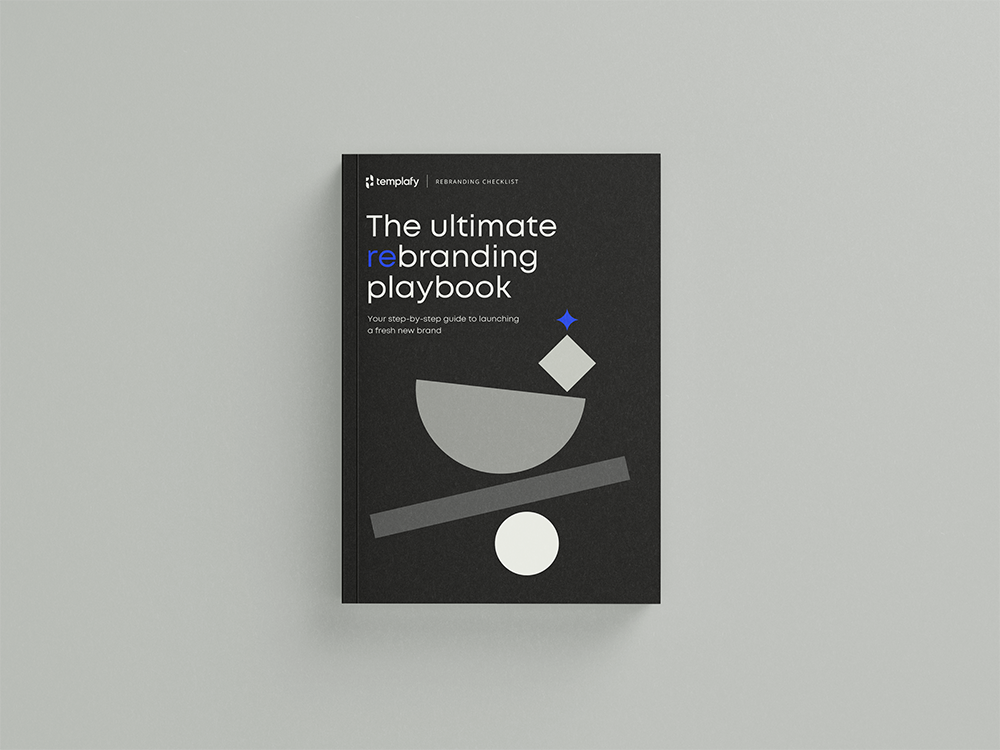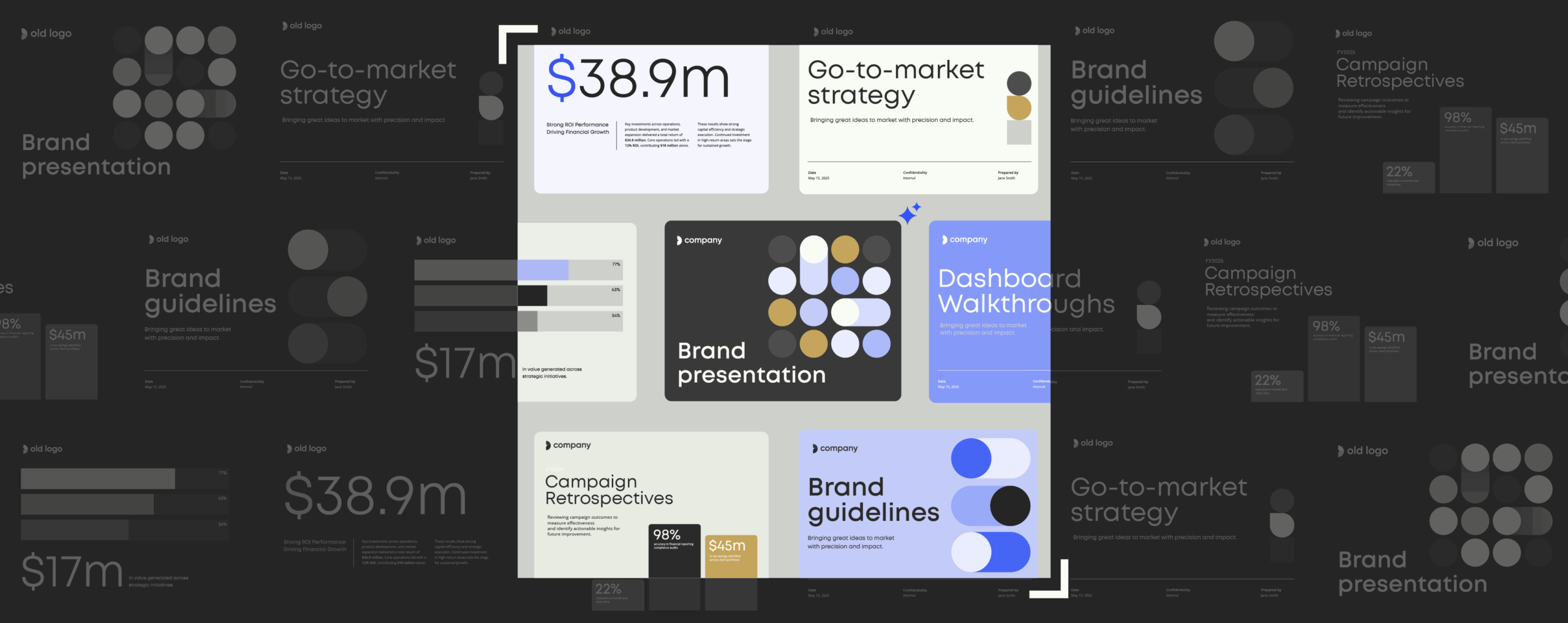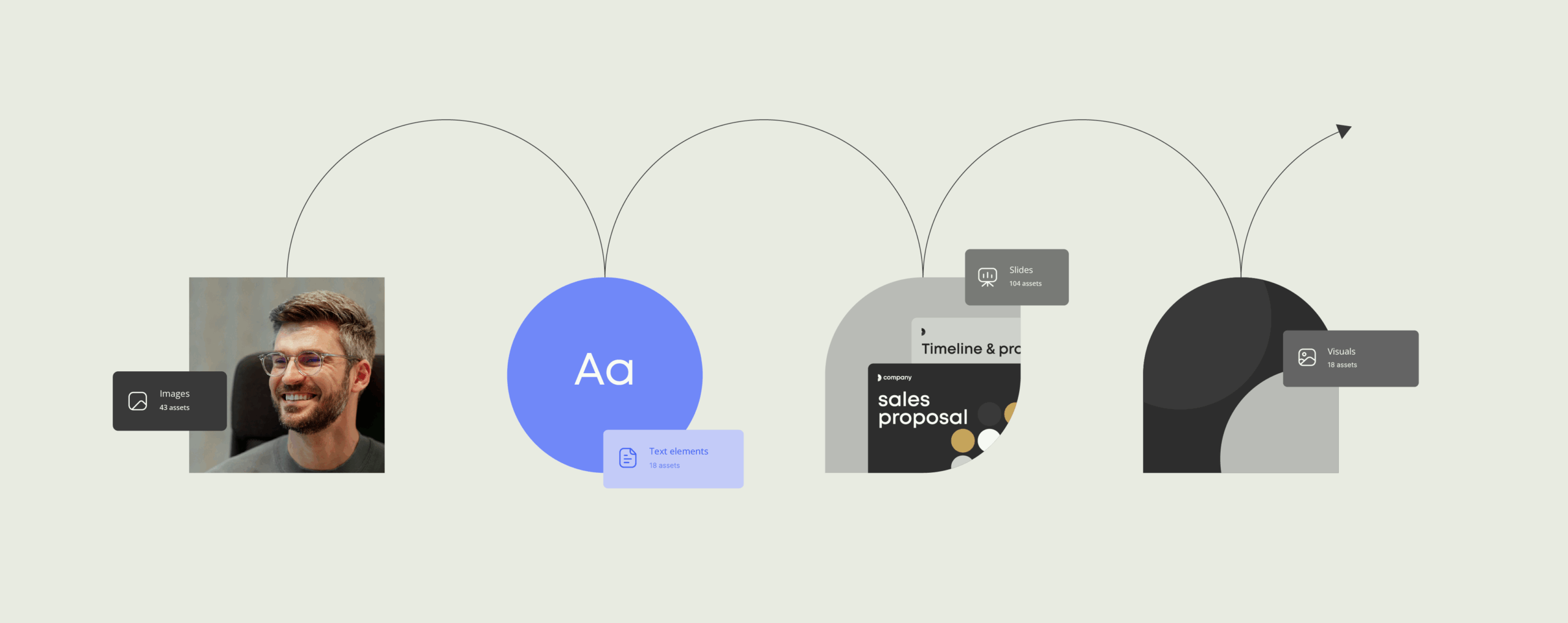Why a strong rebranding strategy is key to post-merger success

When two businesses become one, success is determined by the strength of your rebrand strategy
Mergers and acquisitions can transform a company’s future, but they come with a major challenge—rebranding. What starts as a business decision must quickly be translated into a visual brand identity.
But rebranding after an acquisition is more than updating a logo or merging websites. It requires a strategic approach that considers company culture, customer perception, and global brand consistency. Without a clear plan, businesses risk alienating loyal customers, confusing employees, and weakening the very brand identity that made the acquisition valuable in the first place.
Some companies have successfully navigated this challenge, while others have struggled––or outright failed––with cultural clashes that hurt the brand, the employees, and the bottom line.
In this article, we’ll break down the best practices for rebranding after an acquisition, explore real-world case studies, and highlight how the right tools can help businesses ensure a smooth transition. Whether you’re merging two global brands or integrating a smaller company, a well-executed rebranding strategy makes all the difference.
Choosing the right rebranding strategy
Rebranding is a strategic shift that reshapes how a company is perceived. Businesses rebrand for many reasons, from staying relevant in a changing market to overcoming reputation challenges. But one of the most significant drivers of rebranding is a merger or acquisition.
When two companies come together, they must decide how to present themselves moving forward. A clear rebranding strategy ensures a smooth transition, minimizes confusion, and helps build trust with customers, employees, and stakeholders.
There are different types of rebranding: partial rebranding refreshes elements like a logo or messaging, while total rebranding overhauls the entire identity. Global rebranding happens when a company expands internationally and adjusts to new markets.
After a merger or acquisition, rebranding is especially crucial. It clarifies how the newly combined business will operate, what it stands for, and how it differentiates itself from competitors.
Checklist for a successful rebranding strategy
Rebranding after an acquisition can be overwhelming, but having a clear plan makes all the difference.
Here’s a quick guide to help you organize your strategy:
rebranding strategy
6 steps
- Step 1: Evaluate the brand identities being merged
- Step 2: Establish a shared brand vision
- Step 3: Understand customer expectations and market positioning
- Step 4: Create a comprehensive brand transition plan
- Step 5: Execute a structured brand rollout
- Step 6: Monitor impact and refine as needed
Can’t-miss branding tips
Learn how to keep your brand consistent. Get ideas and examples to help your team create on-brand work with less effort.
Step 1: Evaluate the brand identities being merged
- Assess where the two brands align—and where they don’t.
- Identify overlapping values, strengths, and potential conflicts.
- Conduct internal audits and customer research to determine what to keep, update, or remove.
Step 2: Establish a shared brand vision
- Define the long-term goals of the new brand.
- Decide whether to fully merge into one new brand, keep a primary brand, or maintain a collection of multiple brands.
- Ensure leadership and employees are aligned on the brand’s positioning and messaging.
Step 3: Understand customer expectations and market positioning
- Gather insights on how customers perceive both brands.
- Identify customer concerns about the merger and look for opportunities to build loyalty.
- Research competitors to determine how the new brand can differentiate itself.
Step 4: Create a comprehensive brand transition plan
- Develop a roadmap for brand integration across all touchpoints.
- Refine messaging to reflect the new brand’s values.
- Update visual elements like logos, colors, and typography.
- Provide employees and stakeholders with clear brand guidelines.
Step 5: Execute a structured brand rollout
- Begin with internal alignment before launching publicly.
- Update corporate communications, websites, social media, and marketing materials.
- Provide employees with training and resources to ensure brand consistency.
- Create excitement and engagement through a well-planned launch strategy.
Step 6: Monitor impact and refine as needed
- Track brand perception, customer sentiment, and employee engagement post-launch.
- Gather feedback through surveys, social media, and analytics.
- Make adjustments to messaging and visuals where needed.
- Recognize that rebranding is an ongoing process requiring periodic review.
Read more: The do’s and don’ts of successful rebranding
Don’t miss a step in your new brand launch
Avoid the most common mistakes companies make while rebranding with our collection of helpful checklists.

Rebranding in action: Hits, misses, and lessons learned
Amazon and Whole Foods: The problem with love at first sight
Amazon’s 2017 acquisition of Whole Foods is a classic case of what can go wrong in a brand merger.
When Amazon bought Whole Foods for $13.7 billion, CEO John Mackey called it “love at first sight.” He believed Amazon’s backing could reverse declining sales, lower prices, and expand market share. Amazon, in turn, saw an opportunity to enter brick-and-mortar retail while collecting valuable shopper data.
At first, the future looked bright. But within a year, the cracks showed. Whole Foods employees were reportedly crying at work, accusing Amazon of turning them into “robots.” Many even began unionizing to protect their jobs.
The problem? A total culture clash. Amazon thrives on efficiency, cost-cutting, and strict employee discipline. Whole Foods, on the other hand, had built its brand around employee autonomy and a personal touch. By forcing its rigid structure onto an empowered workforce, Amazon created a hostile environment—and a branding nightmare.
The problem? A total culture clash. Amazon thrives on efficiency, cost-cutting, and strict employee discipline. Whole Foods, on the other hand, had built its brand around employee autonomy and a personal touch. By forcing its rigid structure onto an empowered workforce, Amazon created a hostile environment—and a branding nightmare.
Read more: Internal branding strategies: How to unite your team and strengthen your brand
L’Oréal: The beauty of the acquisition
In the beauty industry, mergers and acquisitions (M&A) are the norm. Few companies do it better than L’Oréal, the world’s largest cosmetics brand, with a market cap of over $230 billion. Decades of strategic acquisitions have fueled its success, and it now boasts what it calls “a global flotilla of complementary brands.”
Unlike many companies that overhaul brands post-acquisition, L’Oréal takes a different approach—it preserves and nurtures them. CEO Jean-Paul Agon credits this strategy for L’Oréal’s dominance, saying, “We offer [acquired brands] total respect of the identity, culture, spirit, and soul of the brand.”
Take Kiehl’s, for example. When L’Oréal acquired the brand in 2000, it had one flagship store in New York and an annual turnover of $20 million. Instead of rebranding, L’Oréal expanded Kiehl’s globally while maintaining its original identity. Today, it’s worth $1 billion, with stores worldwide that mirror the spirit of the original shop.
L’Oréal applies the same philosophy across its acquisitions, from Yves Saint Laurent and Maybelline to tech-driven beauty brands like Modiface. The company’s “buy and grow” strategy allows it to reach new markets, secure innovation, and expand while keeping each brand’s unique essence intact.
By investing in brand identity, rather than erasing it, L’Oréal has built a beauty empire—one acquisition at a time.
Read more: Brand integrity: How to win customer trust and loyalty
EE: Starting with a level playing field
Merging brands is tough, but few industries have faced more challenges than telecoms. As Apple’s iPhone and online marketplaces reshaped the market, telecom giants scrambled to merge or risk fading into irrelevance.
Many didn’t survive. AT&T’s $86 billion acquisition of BellSouth and Vodafone’s $180 billion takeover of Mannesmann saw both acquired brands vanish. Vodafone later suffered massive losses.
But Orange and T-Mobile took a different approach. Rather than erasing one brand, they merged strategically, keeping both names visible in a £4 million co-branded ad campaign. Their joint messaging reassured customers and employees, making the transition smooth.
A year later, the merger led to EE, a new brand built around 4G technology, launched with major marketing efforts—including ads starring Kevin Bacon. The key to its success? A five-year plan that prioritized stability and brand equity, rather than a rushed rebrand.
The telecom industry’s shake-up teaches an important lesson for any declining sector. While mergers create opportunities, without a solid rebranding strategy, even the strongest brands risk disappearing overnight.
Tietoevry: Rebranding after an acquisition with Templafy
Unifying two individual brands after a merger is a delicate process. If done poorly, it can confuse customers, frustrate employees, and weaken brand equity. That’s where Templafy comes in.
A perfect example is Tieto and EVRY, two major Nordic IT service providers that merged in 2019. Together, they formed Tietoevry, a new company with a shared vision but a complex rebranding challenge. With thousands of employees spread across multiple countries, ensuring brand consistency in every piece of communication was no small task.
Using Templafy’s document generation platform, Tietoevry streamlined its branding transition. Employees gained instant access to on-brand templates, digital assets, and approved content, no matter where they worked. This eliminated outdated materials and ensured that every piece of content—from internal memos to client-facing proposals—reflected the new brand identity.
The impact? A faster, smoother brand rollout, with employees empowered to create content that aligned with the newly merged company’s vision. Instead of spending months fixing brand inconsistencies, Tietoevry focused on business growth, confident that its branding was seamlessly integrated across the organization.
For companies going through a merger or acquisition, Templafy removed the guesswork from rebranding. It helps align teams, ensure consistency, and create a strong, unified brand—without the chaos.
Read more: Aligning a global brand and 24k employees with Tietoevry
3 things Brand leaders wish they knew before rebranding
Are you ready to rebrand? Don’t miss these steps
Most common challenges of global rebranding after acquisition
For international brands, rebranding after a merger or acquisition is even more complex. With multiple markets, diverse customer bases, and different cultural expectations, a poorly executed rebrand can lead to confusion, loss of trust, and even financial setbacks.
Unlike local or national brands, global companies must maintain consistency while allowing for regional adaptation. A rebrand that works well in one country may not resonate in another. Logos, slogans, and messaging can have unintended meanings across cultures, making localization a critical part of the process.
Additionally, global brands often have large, distributed workforces that need clear guidelines to stay aligned with the new brand identity. Employees worldwide must have access to the right assets and messaging to ensure a seamless transition. Without a structured brand strategy, teams may continue using outdated materials, weakening the new brand’s impact.
Here are the biggest challenges companies face when rebranding on a global scale after an acquisition—and how to overcome them:
- Cultural differences: Logos, slogans, and colors can have different meanings across regions. Localization is key to maintaining relevance while preserving brand identity.
- Market perception: Customers need to trust the new brand. Research local preferences, competitors, and trends to ensure the rebrand aligns with regional expectations.
- Brand consistency vs. flexibility: A global brand must feel cohesive while allowing room for local adaptation. A centralized brand governance system like Templafy helps maintain balance.
- Merging brand cultures: Acquisitions bring together different work styles, values, and customer expectations. A shared vision that respects both brands is essential for long-term success.
- Clear communication: Employees and customers need to understand the changes. Transparent messaging reassures stakeholders and prevents confusion.
- Maintaining brand consistency: Every touchpoint—emails, presentations, websites, marketing materials, etc.—should reflect the new brand identity. Brand enablement tools like Templafy ensure all employees use the latest, most up-to-date assets.
Rebranding after an acquisition isn’t just about what the website looks like—it’s about aligning strategy, communication, and culture to build a strong, trusted global brand.
Read more: International brand management: Stay consistent and compliant across borders
Successful rebranding is only as good as the underlying strategy
Rebranding after an acquisition isn’t just about adapting to change—it’s about leveraging change as an opportunity. A well-planned rebranding strategy can strengthen a company’s identity, aligning two organizations under a shared vision that inspires employees, reassures customers, and drives long-term growth.
The difference between a successful rebrand and a failed one comes down to strategy and execution. Companies that invest in thoughtful planning, clear communication, and the right tools will navigate mergers smoothly—ensuring that their brand emerges stronger than before.
But no company does it alone. The right tools are essential for creating the infrastructure and expertise to keep branding consistent across everything—from internal documents to customer communications. With the right support, businesses can focus on their vision and future, confident that their brand identity is in good hands.
Templafy helps enterprises maintain brand consistency during and after a rebrand by centralizing brand assets and automating content distribution. With Templafy, marketing and brand teams can ensure that every document, presentation, and email reflects the new brand identity—without relying on manual updates.
The strongest brands take a strategic approach to growing their business, careful to ensure that every change is a step toward a stronger, more unified brand.
Looking for support in an upcoming rebrand?
Book a demo with Templafy to learn more about our centralized template management and content distribution tools.



